Assessment of Children’s Exposure to Intelligent Transport System 5.9 GHz Vehicular Connectivity Using Numerical Dosimetry
Abstract
1. Introduction
2. Materials and Methods
2.1. The Exposure Scenario
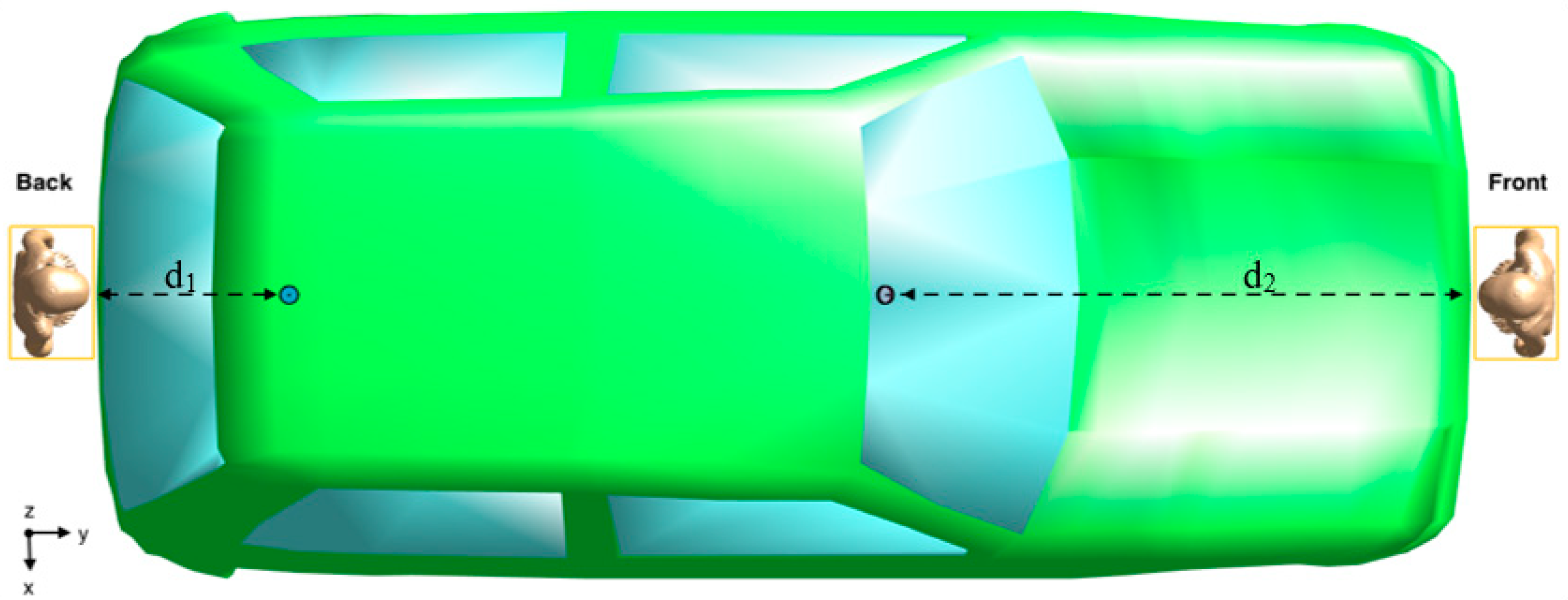
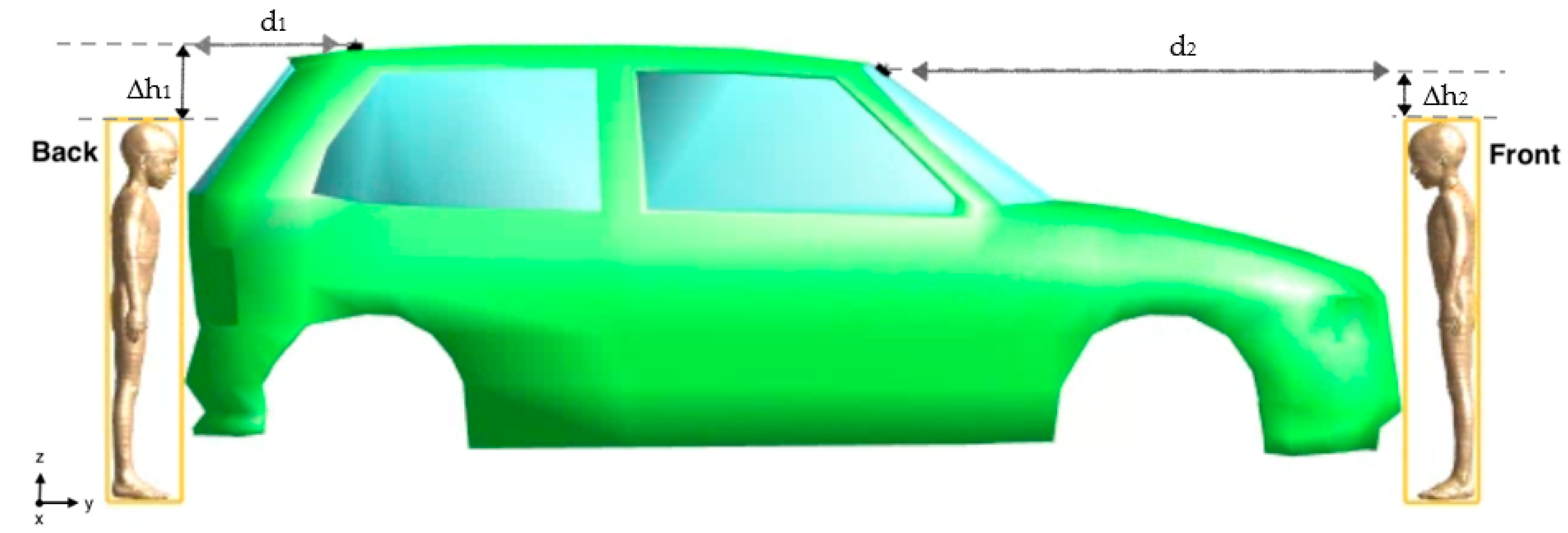
| Human Model | Δh1 (mm) | Δh2 (mm) | d1 (mm) | d2 (mm) |
|---|---|---|---|---|
| Roberta | +319 | +244 | 539 | 1623.2 |
| Thelonious | +241.7 | +166.6 | 547 | 1624.6 |
| Eartha | +46.7 | −28.4 | 540 | 1624 |
| Dizzy | +12.7 | −62.4 | 540 | 1624 |
| Ella | −212.3 | −287.4 | 536 | 1608 |
2.2. Computational Approach
2.3. Exposure Assessment
3. Results
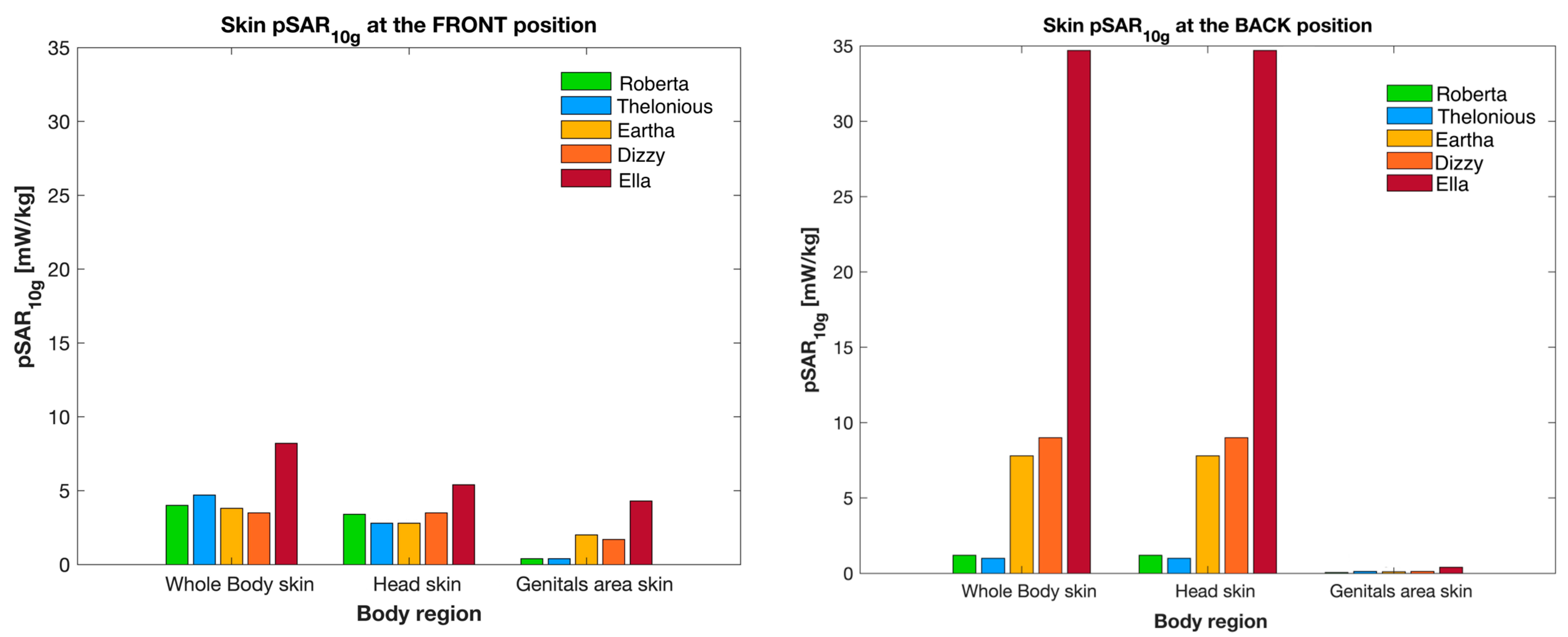
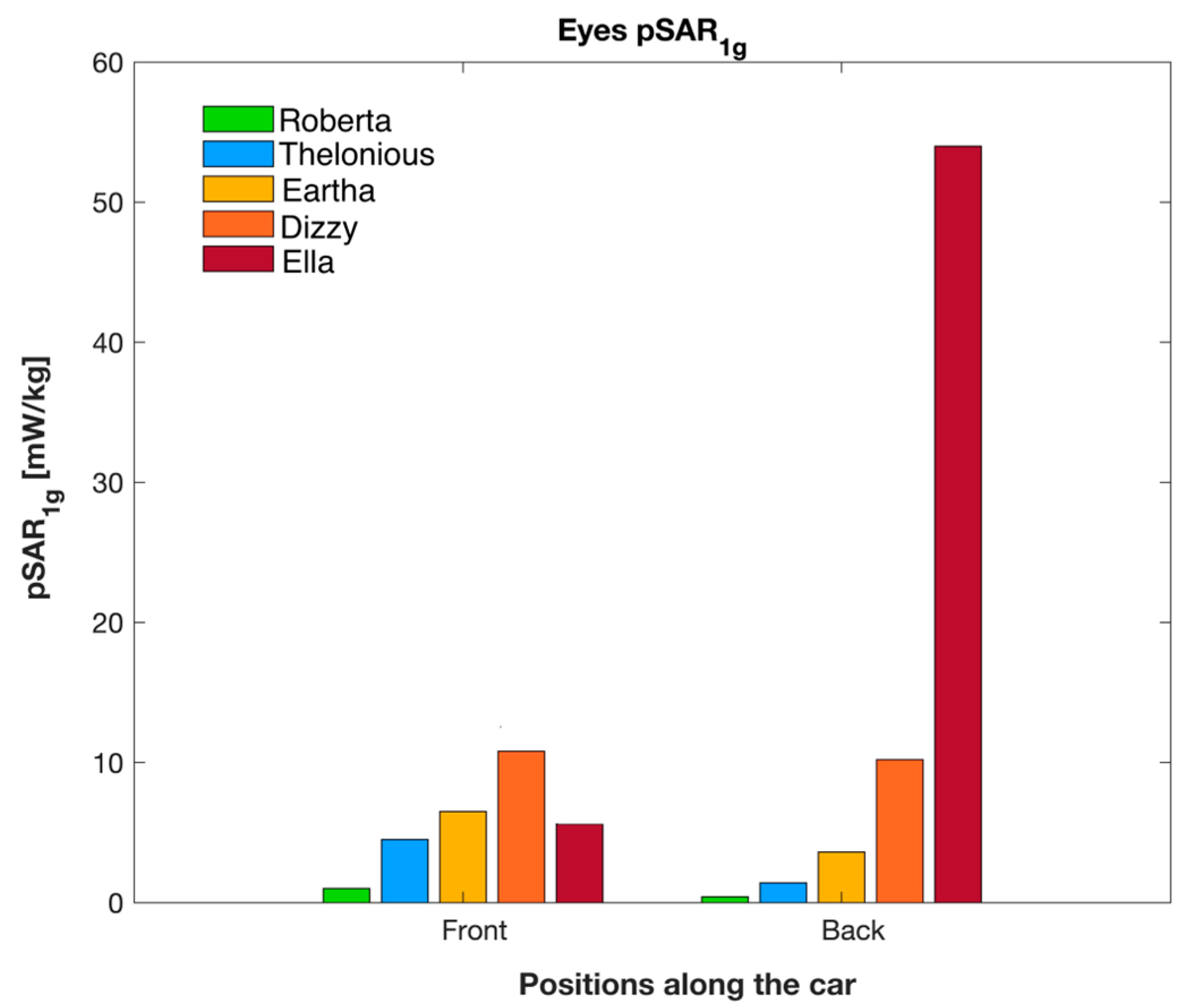
| Human Model | Body Region | pSAR10g Site | |
|---|---|---|---|
| Model Position: Front | Model Position: Back | ||
| Roberta | Whole-body | shoulder | nose |
| Head | chin | nose | |
| Genitals area | upper thigh | upper thigh | |
| Thelonious | Whole-body | arm | forehead |
| Head | forehead | forehead | |
| Genitals area | upper thigh | penis | |
| Eartha | Whole-body | forearm | forehead |
| Head | forehead | forehead | |
| Genitals area | waist | waist | |
| Dizzy | Whole-body | nose | forehead |
| Head | nose | forehead | |
| Genitals area | waist | penis | |
| Ella | Whole-body | hand | nose |
| Head | nose | nose | |
| Genitals area | waist | waist | |
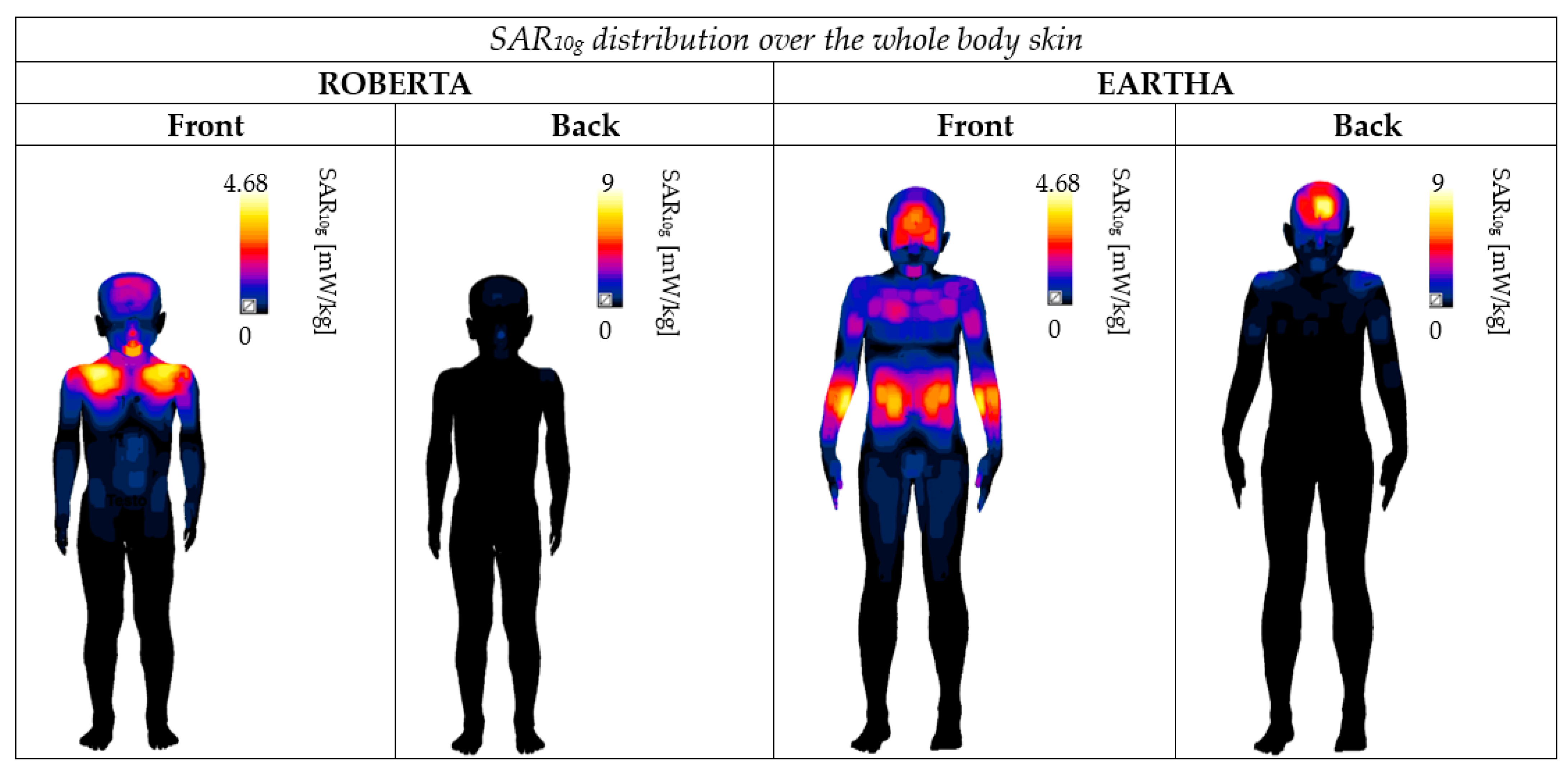
4. Discussion
5. Conclusions
Author Contributions
Funding
Institutional Review Board Statement
Informed Consent Statement
Data Availability Statement
Acknowledgments
Conflicts of Interest
References
- ANAS. Smart Road. The Intelligent Road that Runs with Progress. 2021. Available online: https://www.stradeanas.it/sites/default/files/pdf/Smart_Book_%28eng%29.pdf (accessed on 23 March 2023).
- Rebbeck, T.; Stewart, J.; Lacour, H.A.; Lillen, A.; McClure, D.; Dunoyer, A. Socio-Economic Benefits of Cellular V2X. 2017, Final Report for 5GAA. Available online: https://www.analysysmason.com/globalassets/x_migrated-media/media/analysys-mason-report-for-5gaa-on-socio-economic-benefits-of-cellular-v2x2.pdf (accessed on 23 March 2023).
- Bazzi, A.; Cecchini, G.; Menarini, M.; Masini, B.; Zanella, A. Survey and perspectives of vehicular Wi-Fi versus sidelink cellular-V2X in the 5G era. Future Internet 2019, 11, 122. [Google Scholar] [CrossRef]
- Technical Specification Group Radio Network. Study on New Radio Access Technology: Physical Layer Aspects. 3GPP (Release 14); 3GPP TR 38.802 V14.2.0; 3GPP Support Office: Sophia Antipolis Cedex, France, 2017; Available online: https://panel.castle.cloud/view_spec/38802-e20/pdf/ (accessed on 23 March 2023).
- Technical Specification Group Radio Access Network. Study on Scenarios and Requirements for Next Generation Access Technologies. 3GPP (Release 16); 3GPP TR 38.913 V16.0.0; 3GPP Support Office: Sophia Antipolis Cedex, France, 2020; Available online: https://www.etsi.org/deliver/etsi_tr/138900_138999/138913/16.00.00_60/tr_138913v160000p.pdf (accessed on 23 March 2023).
- Jadhav, A.; Sonpimple, A. Connected car market by technology (2G, 3G, and 4G/LTE), connectivity solutions (integrated, embedded, and tethered), service (driver assistance, safety, entertainment, well-being, vehicle management, and mobility management), and end market (OEM and aftermarket): Global opportunity analysis and industry forecast. Allied Mark. Res. 2018. Available online: https://www.premiummarketinsights.com/reports-amr/connected-car-market (accessed on 23 March 2023).
- IEEE Standard 802.11p-2010; IEEE Standard for Information Technology—Telecommunications and Information Exchange Between Local and Metropolitan Area Networks—Specific Requirements, Part 11: Wireless LAN Medium Access Control (MAC) and Physical Layer (PHY) Specifications Amendment 6: Wireless Access in Vehicular Environments. IEEE: Piscataway, NJ, USA, 2010. [CrossRef]
- Intelligent Transport Systems (ITS). LTE-V2X Access Layer Specification for Intelligent Transport Systems Operating in the 5 GHz Frequency Band. ETSI EN 303 613 V1.1.1. 2020. Available online: https://www.etsi.org/deliver/etsi_en/303600_303699/303613/01.01.01_60/en_303613v010101p.pdf (accessed on 23 March 2023).
- Technical Specification Group Radio Access Network. Study on LTE-Based V2X Services; (Release 14); 3GPP TR 36.885 V14.0.0; 3GPP Support Office: Sophia Antipolis Cedex, France, 2016. [Google Scholar]
- Technical Specification Group Radio Access Network. V2X Services Based on NR; User Equipment (UE) Radio Transmission and Reception (Release 16); 3GPP TR 38.886 V16.3.0; 3GPP Support Office: Valbonne, France, 2021. [Google Scholar]
- LTE. Evolved Universal Terrestrial Radio Access (E-UTRA); User Equipment (UE) Radio Transmission and Reception (Release 14); 3GPP TS 36.101 V 14.20.0; ETSI, 3GPP Support Office: Sophia Antipolis Cedex, France, 2021; Available online: https://www.etsi.org/deliver/etsi_ts/136100_136199/136101/14.20.00_60/ts_136101v142000p.pdf (accessed on 23 March 2023).
- Technical Specification Group Radio Access Network. NR Sidelink Enhancement; User Equipment (UE) Radio Transmission and Reception (Release 17); 3GPP TR 38.785 V0.5.0; 3GPP Support Office: Valbonne, France, 2021. [Google Scholar]
- Tognola, G.; Bonato, M.; Benini, M.; Aerts, S.; Gallucci, S.; Chiaramello, E.; Fiocchi, S.; Parazzini, M.; Masini, B.; Joseph, J.; et al. Survey of Exposure to RF Electromagnetic Fields in the Connected Car. IEEE Access 2022, 10, 47764–47781. [Google Scholar] [CrossRef]
- Tognola, G.; Masini, B.; Gallucci, S.; Bonato, M.; Fiocchi, S.; Chiaramello, E.; Parazzini, M.; Ravazzani, P. Numerical Assessment of RF Human Exposure in Smart Mobility Communications. IEEE J. Electromagn. RF Microw. Med. Biol. 2021, 5, 100–107. [Google Scholar] [CrossRef]
- Benini, M.; Parazzini, M.; Bonato, M.; Gallucci, S.; Chiaramello, E.; Fiocchi, S.; Tognola, G. Road user exposure from ITS-5.9 GHz vehicular connectivity. Sensors 2022, 22, 6986. [Google Scholar] [CrossRef] [PubMed]
- Bonato, M.; Tognola, G.; Benini, M.; Gallucci, S.; Chiaramello, E.; Fiocchi, S.; Parazzini, M. Assessment of SAR in road-users from 5G-V2X vehicular connectivity based on computational simulations. Sensors 2022, 22, 6564. [Google Scholar] [CrossRef] [PubMed]
- International Commission on Non-Ionizing Radiation Protection (ICNIRP). Guidelines for limiting exposure to electromagnetic fields (100 kHz to 300 GHz). Health Phys. 2020, 118, 483–524. [Google Scholar] [CrossRef] [PubMed]
- IEEE Standard C95.1-2019; IEEE Standard for Safety Levels with Respect to Human Exposure to Electric, Magnetic, and Electromagnetic Fields, 0 Hz to 300 GHz. IEEE: New York, NY, USA, 2019; pp. 1–312.
- Gallo, M.; Bruni, S.; Pannozzo, M.; Zamberlan, D. Performance Evaluation of C2C Antennas on Car Body. In Proceedings of the 7th European Conference on Antennas and Propagation (EuCAP2013), Gothenburg, Sweden, 8–12 April 2013; pp. 3136–3139. [Google Scholar]
- TE connectivity. V2X—An Important Building Block in Cooperative Intelligent Transport Systems (C-ITS). 2019. Available online: https://www.te.com/content/dam/te-com/documents/automotive/global/automotive-next-gen-mobility-v2x-09-2019-en.pdf (accessed on 23 March 2023).
- Autotalks. Cost-Efficient C-V2X Antenna Installation. 2020. Available online: https://auto-talks.com/wp-content/uploads/2021/07/Cost-efficient-C-V2X-Antenna-Installation-final.pdf (accessed on 23 March 2023).
- Ruddle, A. Influence of Dielectric Materials on In-Vehicle Electromagnetic Fields. In Proceedings of the 2008 IET Seminar on Electromagnetic Propagation in Structures and Buildings, London, UK, 4 December 2008; pp. 1–6. [Google Scholar] [CrossRef]
- Christ, A.; Kainz, W.; Hahn, G.E.; Honegger, K.; Zefferer, M.; Neufeld, E.; Rascher, W.; Janka, R.; Bautz, W.; Chen, J. The virtual family-development of surface-based anatomical models of two adults and two children for dosimetric simulations. Phys. Med. Biol. 2010, 55, N23–N38. [Google Scholar] [CrossRef] [PubMed]
- IEEE/IEC 62704-2; International Standard for Determining the Peak Spatial Average Specific Absorption Rate (SAR) in the Human Body form Wireless Communications Devices, 30 MHz–6 GHz, Part 2: Specific Requirements for Finite Different Time Domain (FDTD) Modelling of Exposure from Vehicle Mounted Antennas. IEEE: New York, NY, USA, 2017. Available online: https://ieeexplore.ieee.org/stamp/stamp.jsp?tp=&arnumber=7964816 (accessed on 23 March 2023).
- ZMT Zurich Med Tech AG, Zurich, Switzerland. Available online: https://www.zurichmedtech.com (accessed on 23 March 2023).
- Gosselin, M.C.; Neufeld, E.; Moser, H.; Huber, E.; Farcito, S.; Gerber, L.; Jedensjö, M.; Hilber, I.; Di Gennaro, F.; Lloyd, B.; et al. Development of a new generation of high-resolution anatomical models for medical device evaluation: The Virtual Population 3.0. Phys. Med. Biol. 2014, 59, 5287. [Google Scholar] [CrossRef] [PubMed]
- Gabriel, C.; Gabriel, S.; Corthout, E. The dielectric properties of biological tissues: I. Literature survey. Phys. Med. &Biol. 1996, 41, 2231. [Google Scholar] [CrossRef]
- Gabriel, S.; Lau, R.W.; Gabriel, C. The dielectric properties of biological tissues: II. Measurements in the frequency range 10 Hz to 20 GHz. Phys. Med. Biol. 1996, 41, 2251–2269. [Google Scholar] [CrossRef] [PubMed]
- Harrington, R.F. Time-Harmonic Electromagnetic Fields; McGraw-Hill College: New York, NY, USA, 1961. [Google Scholar]
- Wong, A.M.; Eleftheriades, G.V. Active Huygens’ box: Arbitrary electromagnetic wave generation with an electronically controlled metasurface. IEEE Trans. Antennas Propag. 2020, 69, 1455–1468. [Google Scholar] [CrossRef]
- Benkler, S.; Chavannes, N.; Kuster, N. Novel FDTD Huygens source enables highly complex simulation scenarios on ordinary PCs. In IEEE Antennas and Propagation Society International Symposium; USNC/URSI National Radio Science: North Charleston, SC, USA, 2009; pp. 1–4. [Google Scholar] [CrossRef]
- Sasaki, K.; Wake, K.; Watanabe, S. Measurement of the dielectric properties of the epidermis and dermis at frequencies from 0.5 GHz to 110 GHz. Phys. Med. Biol. 2014, 59, 4739. [Google Scholar] [CrossRef] [PubMed]
- Foster, K.R.; Ziskin, M.C.; Balzano, Q. Thermal response of human skin to microwave energy: A critical review. Health Phys. 2016, 111, 528–541. [Google Scholar] [CrossRef] [PubMed]
- Murphy, W.; Black, J.; Hastings, G.W. Handbook of Biomaterial Properties; Springer: New York, NY, USA, 2016; Volume 676. [Google Scholar]


| Name | Sex | Age (Year) | Height (m) | Weight (kg) | BMI (kg/m2) |
|---|---|---|---|---|---|
| Roberta | female | 5 | 1.1 | 17.6 | 14.8 |
| Thelonious | male | 6 | 1.16 | 18.6 | 13.8 |
| Eartha | female | 8 | 1.36 | 29.9 | 16.2 |
| Dizzy | male | 8 | 1.37 | 25.3 | 13.5 |
| Ella | female | 26 | 1.63 | 57.3 | 21.6 |
| Human Model | Huygens Box (mm) |
|---|---|
| Roberta | 366 × 241 × 1136 |
| Thelonious | 396 × 246 × 1211 |
| Eartha | 481 × 273 × 1419 |
| Dizzy | 439 × 266 × 1461 |
| Human Model | wbSAR (mW/kg) | |
|---|---|---|
| Front | Back | |
| Roberta | 0.15 | 0.02 |
| Thelonious | 0.15 | 0.03 |
| Eartha | 0.17 | 0.10 |
| Dizzy | 0.18 | 0.14 |
| Ella | 0.17 | 0.19 |
| Body Region | Parameters | Roberta | Thelonious | Eartha | Dizzy | Ella | |||||
|---|---|---|---|---|---|---|---|---|---|---|---|
| Front | Back | Front | Back | Front | Back | Front | Back | Front | Back | ||
| Skin of the Whole Body | - SAR10g maximum (mW/kg) | 4.00 | 1.18 | 4.68 | 1.04 | 3.83 | 7.80 | 3.54 | 9.00 | 8.20 | 34.70 |
| - SAR10g Median (mW/kg) | 0.04 | 0.01 | 0.04 | 0.01 | 0.06 | 0.01 | 0.05 | 0.01 | 0.06 | 0.03 | |
| - Skewness | 3.00 | 4.40 | 3.57 | 3.92 | 2.32 | 5.70 | 2.38 | 5.54 | 2.50 | 5.27 | |
| Skin of the head region | - SAR10g maximum (mW/kg) | 3.37 | 1.18 | 2.84 | 1.04 | 2.80 | 7.80 | 3.54 | 9.00 | 5.40 | 34.70 |
| - SAR10g Median (mW/kg) | 0.52 | 0.09 | 0.20 | 0.10 | 0.30 | 0.30 | 0.40 | 0.60 | 0.05 | 0.30 | |
| -Skewness | 1.37 | 1.64 | 1.95 | 1.00 | 1.54 | 1.78 | 1.31 | 1.4 | 2.14 | 2.19 | |
| Skin of the genital region | - SAR10g maximum (mW/kg) | 0.38 | 0.05 | 0.39 | 0.12 | 2.04 | 0.10 | 1.71 | 0.12 | 4.30 | 0.40 |
| - SAR10g Median (mW/kg) | 0.02 | 0 | 0.02 | 0 | 0.06 | 0 | 0.08 | 0 | 0.02 | 0 | |
| -Skewness | 1.77 | 1.43 | 1.16 | 1.00 | 2.77 | 1.45 | 2.80 | 1.38 | 1.88 | 2.10 | |
| Eyes | - SAR1g maximum (mW/kg) | 1.05 | 0.40 | 4.47 | 1.37 | 6.50 | 3.60 | 10.80 | 10.20 | 5.61 | 54.00 |
| - SAR1g Median (mW/kg) | 0.10 | 0.03 | 0.50 | 0.10 | 0.60 | 0.30 | 1.30 | 1.30 | 0.30 | 3.00 | |
| - Skewness | 1.63 | 1.73 | 1.67 | 1.72 | 1.82 | 2.14 | 1.56 | 1.61 | 2.23 | 2.20 | |
Disclaimer/Publisher’s Note: The statements, opinions and data contained in all publications are solely those of the individual author(s) and contributor(s) and not of MDPI and/or the editor(s). MDPI and/or the editor(s) disclaim responsibility for any injury to people or property resulting from any ideas, methods, instructions or products referred to in the content. |
© 2023 by the authors. Licensee MDPI, Basel, Switzerland. This article is an open access article distributed under the terms and conditions of the Creative Commons Attribution (CC BY) license (https://creativecommons.org/licenses/by/4.0/).
Share and Cite
Benini, M.; Parazzini, M.; Bonato, M.; Gallucci, S.; Chiaramello, E.; Fiocchi, S.; Tognola, G. Assessment of Children’s Exposure to Intelligent Transport System 5.9 GHz Vehicular Connectivity Using Numerical Dosimetry. Sensors 2023, 23, 5170. https://doi.org/10.3390/s23115170
Benini M, Parazzini M, Bonato M, Gallucci S, Chiaramello E, Fiocchi S, Tognola G. Assessment of Children’s Exposure to Intelligent Transport System 5.9 GHz Vehicular Connectivity Using Numerical Dosimetry. Sensors. 2023; 23(11):5170. https://doi.org/10.3390/s23115170
Chicago/Turabian StyleBenini, Martina, Marta Parazzini, Marta Bonato, Silvia Gallucci, Emma Chiaramello, Serena Fiocchi, and Gabriella Tognola. 2023. "Assessment of Children’s Exposure to Intelligent Transport System 5.9 GHz Vehicular Connectivity Using Numerical Dosimetry" Sensors 23, no. 11: 5170. https://doi.org/10.3390/s23115170
APA StyleBenini, M., Parazzini, M., Bonato, M., Gallucci, S., Chiaramello, E., Fiocchi, S., & Tognola, G. (2023). Assessment of Children’s Exposure to Intelligent Transport System 5.9 GHz Vehicular Connectivity Using Numerical Dosimetry. Sensors, 23(11), 5170. https://doi.org/10.3390/s23115170











